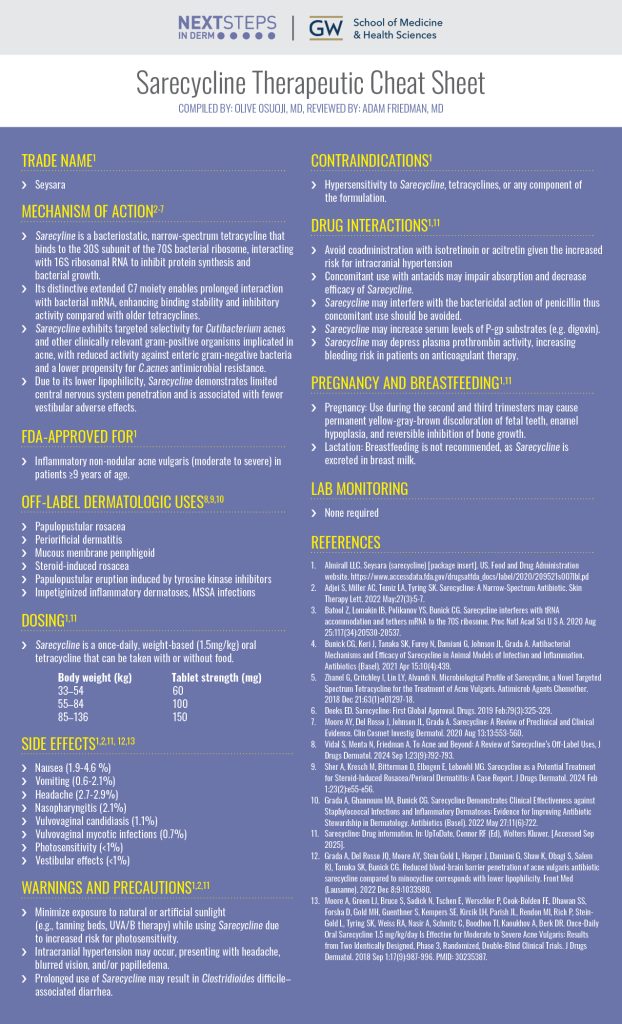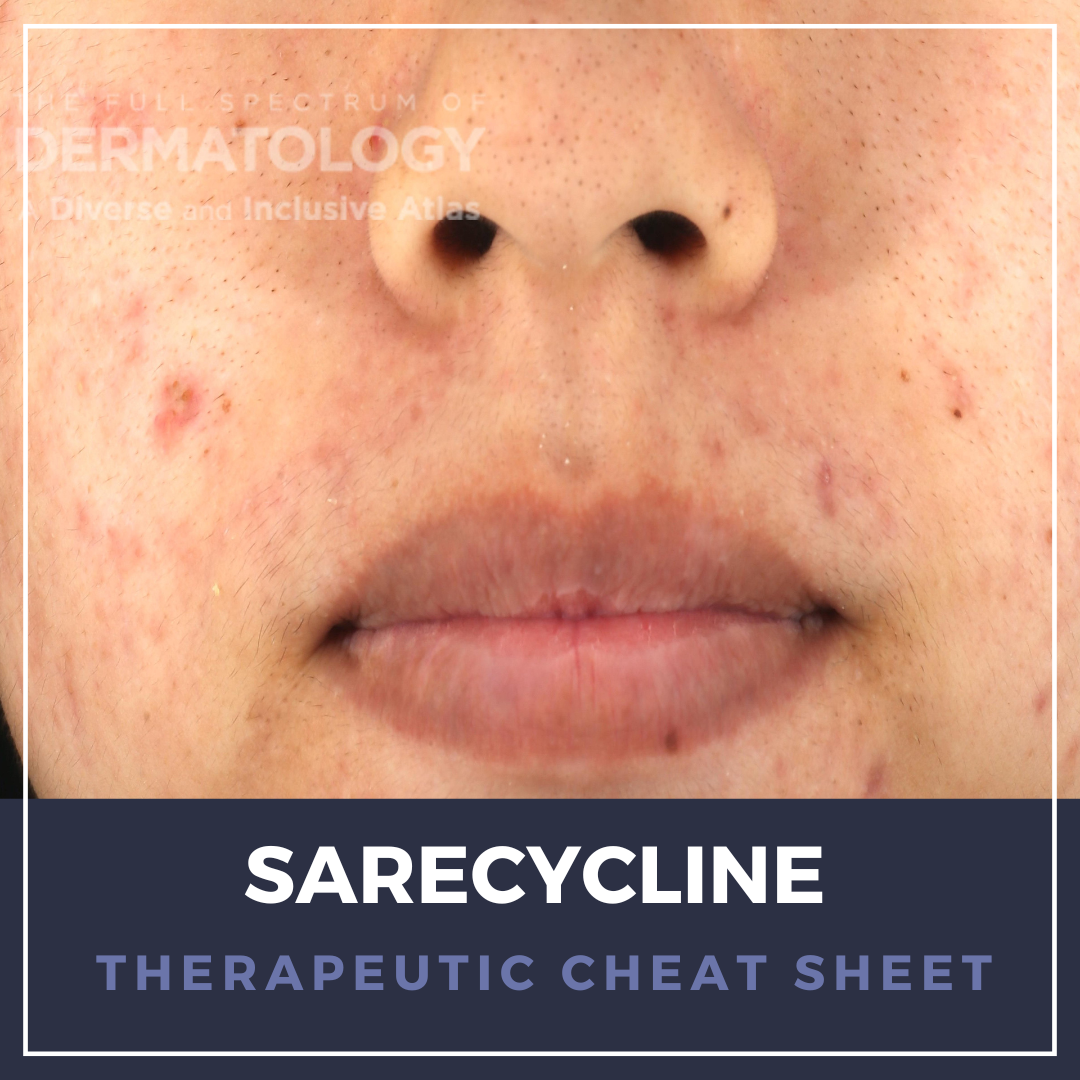Sarecycline is a third-generation, narrow-spectrum tetracycline developed specifically for the treatment of acne vulgaris. It is distinguished by its weight-based once-daily dosing, favorable side effect profile, and relative microbiome-sparing compared with older tetracyclines. We continue our series, Therapeutic Cheat Sheet, with a closer look at Sarecycline.
Sarecycline Therapeutic Cheat Sheet
Compiled by: Olive Osuoji, MD | Reviewed by: Adam Friedman, MD
TRADE NAME1
Seysara
MECHANISM OF ACTION2-7
-
- Sarecyline is a bacteriostatic, narrow-spectrum tetracycline that binds to the 30S subunit of the 70S bacterial ribosome, interacting with 16S ribosomal RNA to inhibit protein synthesis and bacterial growth.
- Its distinctive extended C7 moiety enables prolonged interaction with bacterial mRNA, enhancing binding stability and inhibitory activity compared with older tetracyclines.
- Sarecycline exhibits targeted selectivity for Cutibacterium acnesand other clinically relevant gram-positive organisms implicated in acne, with reduced activity against enteric gram-negative bacteria and a lower propensity for acnes antimicrobial resistance.
- Due to its lower lipophilicity, Sarecycline demonstrates limited central nervous system penetration and is associated with fewer vestibular adverse effects.
FDA APPROVED FOR1
-
- Inflammatory non-nodular acne vulgaris (moderate to severe) in patients ≥9 years of age.
OFF-LABEL DERMATOLOGIC USES8,9,10
-
- Papulopustular rosacea
- Periorificial dermatitis
- Mucous membrane pemphigoid
- Steroid-induced rosacea
- Papulopustular eruption induced by tyrosine kinase inhibitors
- Impetiginized inflammatory dermatoses, MSSA infections
DOSING1,11
Sarecycline is a once-daily, weight-based (1.5mg/kg) oral tetracycline that can be taken with or without food.
| Body weight (kg) | Tablet strength (mg) |
| 33–54 | 60 |
| 55–84 | 100 |
| 85–136 | 150 |
SIDE EFFECTS1,2,11, 12,13
-
- Nausea (1.9-4.6 %)
- Vomiting (0.6-2.1%)
- Headache (2.7-2.9%)
- Nasopharyngitis (2.1%)
- Vulvovaginal candidiasis (1.1%)
- Vulvovaginal mycotic infections (0.7%)
- Photosensitivity (<1%)
- Vestibular effects (<1%)
WARNINGS AND PRECAUTIONS1,2,11
-
- Minimize exposure to natural or artificial sunlight (e.g., tanning beds, UVA/B therapy) while using Sarecycline due to increased risk for photosensitivity.
- Intracranial hypertension may occur, presenting with headache, blurred vision, and/or papilledema.
- Prolonged use of Sarecycline may result in Clostridioides difficile–associated diarrhea.
CONTRAINDICATIONS1
-
- Hypersensitivity to sarecycline, tetracyclines, or any component of the formulation.
DRUG INTERACTIONS1,11
-
- Avoid coadministration with isotretinoin or acitretin given the increased risk for intracranial hypertension
- Concomitant use with antacids may impair absorption and decrease efficacy of Sarecycline.
- Sarecycline may interfere with the bactericidal action of penicillin thus concomitant use should be avoided.
- Sarecycline may increase serum levels of P-gp substrates (e.g. digoxin).
- Sarecycline may depress plasma prothrombin activity, increasing bleeding risk in patients on anticoagulant therapy.
PREGNANCY AND BREASTFEEDING1,11
-
- Pregnancy: Use during the second and third trimesters may cause permanent yellow-gray-brown discoloration of fetal teeth, enamel hypoplasia, and reversible inhibition of bone growth.
- Lactation: Breastfeeding is not recommended, as sarecycline is excreted in breast milk.
LAB MONITORING
-
- None required

FURTHER READING
If you would like to learn more about Sarecycline, check out the following articles in the Journal of Drugs in Dermatology:
Ensuring Dermatologists Practice Enhanced Antibiotic Stewardship with Sarecycline Mnemonic
Jordan Bourash, Christopher G Bunick, Emmy Graber
Abstract
It must be ensured that dermatologists practice enhanced antibiotic stewardship to combat
antimicrobial resistance and negative consequences of microbiome dysbiosis. Inorder to help
achieve this, we have developed a mnemonic ENLIGHTEN to help healthcare providers and
patients understand sarecycline’s features.
J Drugs Dermatol. 2023;22(10):1061
Successful Treatment of Periorificial Dermatitis with Novel Narrow Spectrum Sarecycline
Emmy Graber, Catherine Rs Kay
Abstract
Broad spectrum tetracyclines are a well-known, widely used, and often successful treatment for use in inflammatory skin pathologies such as acne and rosacea. However, the steady rise of antibiotic resistance and gut dysbiosis associated with broad spectrum tetracyclines emphasizes the importance and responsibility of antibiotic stewardship. Narrow spectrum antibiotics have become increasingly important therapies to slow the progression of resistance as well as decrease negative side effect profiles, particularly those associated with broad spectrum tetracyclines. This case shows the successful treatment of periorificial dermatitis with a novel, narrow spectrum tetracycline, sarecycline, in a patient with underlying Crohns
J Drugs Dermatol. 2021 Jan 1;20(1):98-100.
REFERENCES
-
- Almirall LLC. Seysara (sarecycline) [package insert]. US. Food and Drug Administration website. https://www.accessdata.fda.gov/drugsatfda_docs/label/2020/209521s007lbl.pd
- Adjei S, Miller AC, Temiz LA, Tyring SK. Sarecycline: A Narrow-Spectrum Antibiotic. Skin Therapy Lett. 2022 May;27(3):5-7.
- Batool Z, Lomakin IB, Polikanov YS, Bunick CG. Sarecycline interferes with tRNA accommodation and tethers mRNA to the 70S ribosome. Proc Natl Acad Sci U S A. 2020 Aug 25;117(34):20530-20537.
- Bunick CG, Keri J, Tanaka SK, Furey N, Damiani G, Johnson JL, Grada A. Antibacterial Mechanisms and Efficacy of Sarecycline in Animal Models of Infection and Inflammation. Antibiotics (Basel). 2021 Apr 15;10(4):439.
- Zhanel G, Critchley I, Lin LY, Alvandi N. Microbiological Profile of Sarecycline, a Novel Targeted Spectrum Tetracycline for the Treatment of Acne Vulgaris. Antimicrob Agents Chemother. 2018 Dec 21;63(1):e01297-18.
- Deeks ED. Sarecycline: First Global Approval. Drugs. 2019 Feb;79(3):325-329.
- Moore AY, Del Rosso J, Johnson JL, Grada A. Sarecycline: A Review of Preclinical and Clinical Evidence. Clin Cosmet Investig Dermatol. 2020 Aug 13;13:553-560.
- Vidal S, Menta N, Friedman A. To Acne and Beyond: A Review of Sarecycline’s Off-Label Uses, J Drugs Dermatol. 2024 Sep 1;23(9):792-793.
- Sher A, Kresch M, Bitterman D, Elbogen E, Lebowhl MG. Sarecycline as a Potential Treatment for Steroid-Induced Rosacea/Perioral Dermatitis: A Case Report. J Drugs Dermatol. 2024 Feb 1;23(2):e55-e56.
- Grada A, Ghannoum MA, Bunick CG. Sarecycline Demonstrates Clinical Effectiveness against Staphylococcal Infections and Inflammatory Dermatoses: Evidence for Improving Antibiotic Stewardship in Dermatology. Antibiotics (Basel). 2022 May 27;11(6):722.
- Sarecycline: Drug information. In: UpToDate, Connor RF (Ed), Wolters Kluwer. [Accessed Sep 2025].
- Grada A, Del Rosso JQ, Moore AY, Stein Gold L, Harper J, Damiani G, Shaw K, Obagi S, Salem RJ, Tanaka SK, Bunick CG. Reduced blood-brain barrier penetration of acne vulgaris antibiotic sarecycline compared to minocycline corresponds with lower lipophilicity. Front Med (Lausanne). 2022 Dec 8;9:1033980.
- Moore A, Green LJ, Bruce S, Sadick N, Tschen E, Werschler P, Cook-Bolden FE, Dhawan SS, Forsha D, Gold MH, Guenthner S, Kempers SE, Kircik LH, Parish JL, Rendon MI, Rich P, Stein-Gold L, Tyring SK, Weiss RA, Nasir A, Schmitz C, Boodhoo TI, Kaoukhov A, Berk DR. Once-Daily Oral Sarecycline 1.5 mg/kg/day Is Effective for Moderate to Severe Acne Vulgaris: Results from Two Identically Designed, Phase 3, Randomized, Double-Blind Clinical Trials. J Drugs Dermatol. 2018 Sep 1;17(9):987-996. PMID: 30235387.
Did you enjoy this Therapeutic Cheat Sheet? You can find more here.

